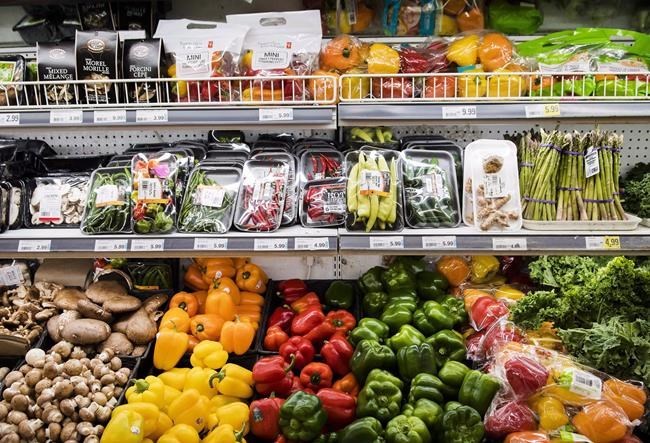
Produce is shown in a grocery store in Toronto on Friday, Nov. 30, 2018. Statistics Canada released its April reading of inflation today. THE CANADIAN PRESS/Nathan Denette
Republished May 18, 2022 - 9:48 AM
Original Publication Date May 18, 2022 - 1:01 AM
OTTAWA - The cost of nearly everything at the grocery store continued to climb higher to help push the annual inflation rate to a fresh three-decade high in April and economists warn prices could continue to heat up.
Statistics Canada said Wednesday that its consumer price index for April rose 6.8 per cent compared with a year ago, up from a gain of 6.7 per cent for March. That's the highest since January 1991, when the annual rate was 6.9 per cent.
"The key takeaway from April's CPI release is that inflation is spreading much more broadly, and at clear risk of getting firmly entrenched," Bank of Montreal chief economist Douglas Porter wrote in a brief report.
"Barring a deep dive in oil prices in coming weeks and months, we expect that the worst is yet to come on the headline readings, and that inflation north of six per cent will still be with us by the end of this year."
James Orlando, a director at TD Bank, said he expects little reprieve going forward with the persistence of food inflation, a continuation of rent price increases, rising mortgage interest costs, and a jump in gasoline prices.
"Anyone who has filled up their tank over the last couple of weeks knows that an acceleration of prices will show up in next month's CPI print," he said.
In its monetary policy report last month, the Bank of Canada said it expected inflation to average almost six per cent in the first half of the year before easing later this year. However, the bank has since said it will likely be revising its forecast.
The central bank raised its key interest rate target by half a percentage point to one per cent last month and warned more interest rate hikes are coming as it works to try to bring inflation back to its target of two per cent. The increase prompted Canada's big commercial banks to raise their prime rates, which in turn raised the cost of loans linked to the benchmark such as variable-rate mortgages.
Economists said the latest inflation report bolstered expectations that the Bank of Canada will raise its key interest rate target by half a percentage point again on June 1 to bring it to 1.5 per cent.
"Overall, elevated consumer spending, tight labour market conditions and higher wage growth are expected to maintain pressure on the Bank of Canada to hike rates quickly, including another 50 basis point increase in the overnight rate expected at the next policy decision," RBC economist Claire Fan wrote.
Overall food costs in April rose 8.8 per cent compared with a year ago, while Canadians paid 9.7 per cent more for food at stores in April, the largest increase since September 1981. The cost of food in restaurants was up 6.6 per cent.
Compared with a year ago, the cost of fresh fruit was up 10 per cent, fresh vegetables gained 8.2 per cent and meat rose 10.1 per cent. The cost of bread rose 12.2 per cent, while pasta gained 19.6 per cent and rice added 7.4 per cent.
Russia's invasion of Ukraine in late February has put upward price pressure on food products that use wheat, Statistics Canada said, while poor weather in growing regions has also impacted prices for food.
The agency also said higher prices for things such as fertilizer and natural gas continued to increase the cost for farmers, who have passed along some of these costs.
Also contributing to the overall rise in the cost of living was a 7.4 per cent increase in shelter costs as the cost to heat a home climbed higher. Natural gas rose 22.2 per cent and fuel oil and other fuels gained 64.4 per cent.
Compared with a year ago, consumers paid 36.3 per cent more for gasoline in April, however the increase was smaller than the year-over-year gain of 39.8 per cent in March.
Excluding gasoline, the annual rate for April was 5.8 per cent compared with a year-over-year gain of 5.5 per cent for March.
The average of the three measures of core inflation that are closely watched by the Bank of Canada rose to 4.23 per cent in April compared with 3.93 per cent in March.
This report by The Canadian Press was first published May 18, 2022.
News from © The Canadian Press, 2022